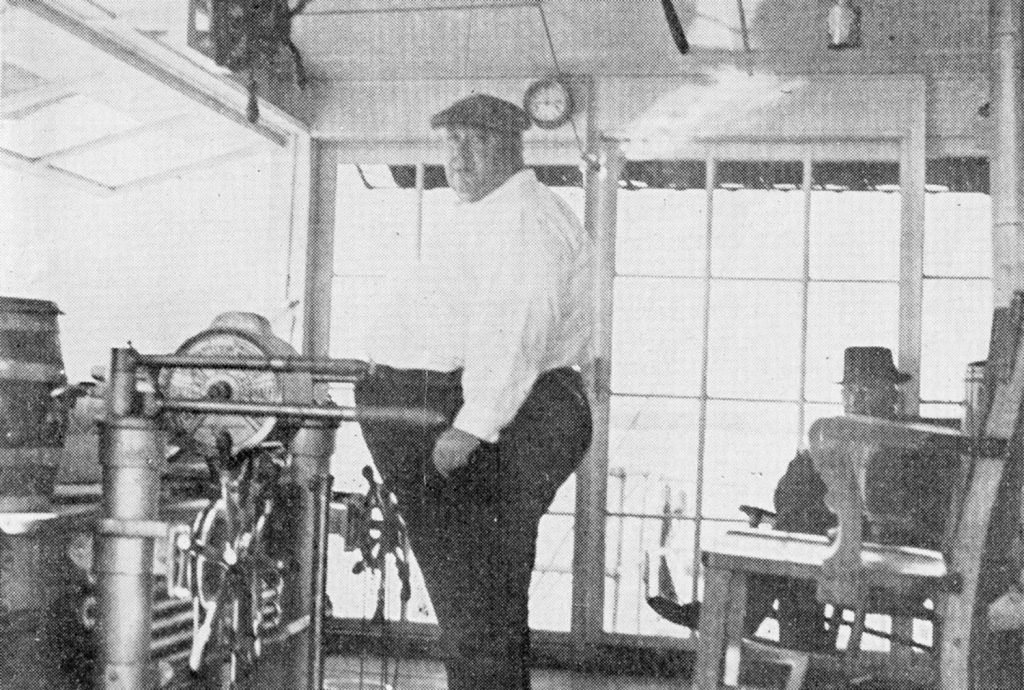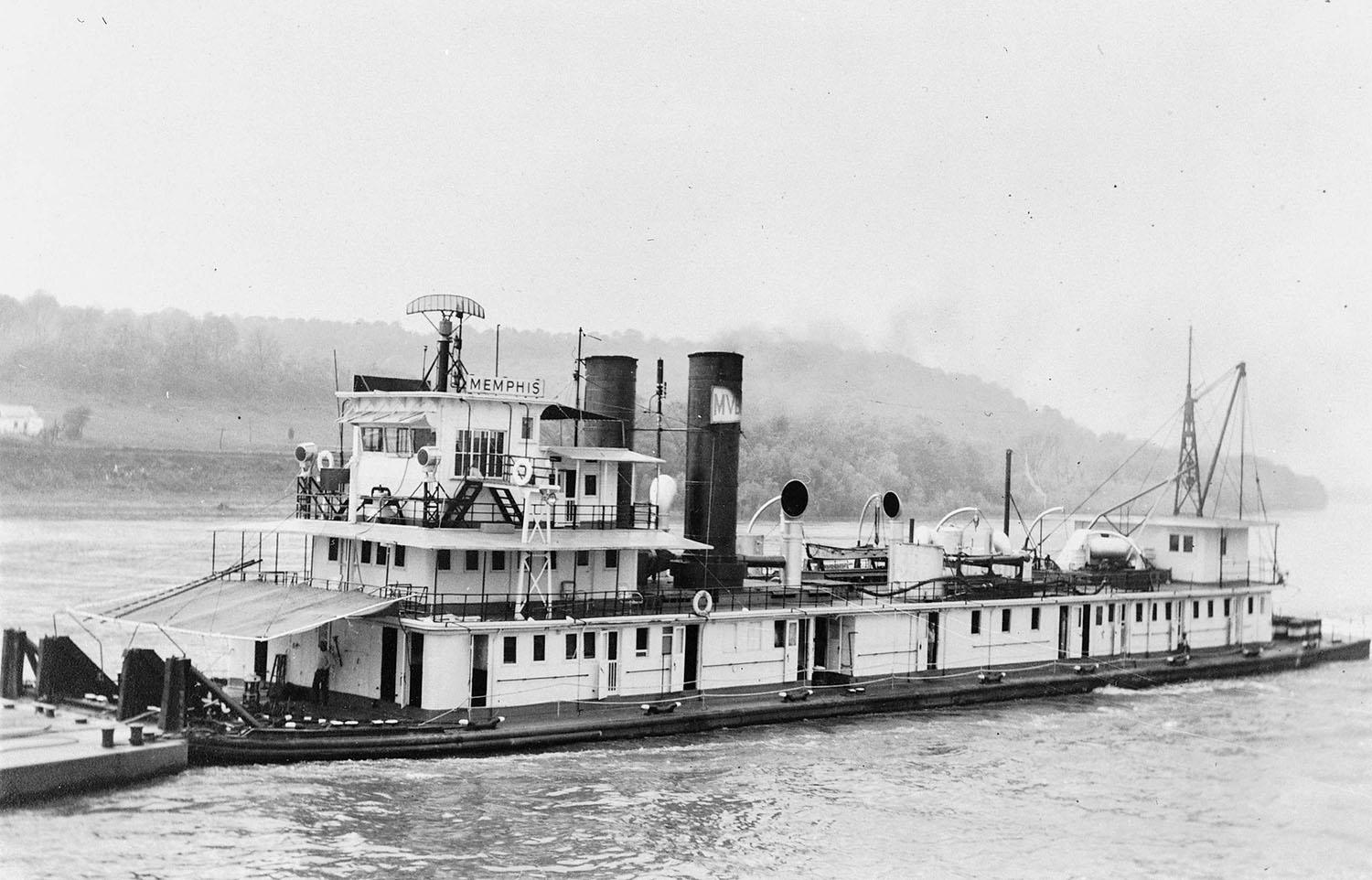In the August 1, 2022, issue of The Waterways Journal, this column looked at the ill-fated “black boat” Natchez, one of a series of steam prop towboats built by the Inland Waterways Corporation (IWC) in 1921. These six boats were named after river cities and due to being painted a very dark green color were also dubbed the black boats. The Natchez and Vicksburg were built by the Charles Ward Engineering Works, Charleston, W.Va., while the other four were built by the Marietta Manufacturing Company (MMC) at Point Pleasant, W.Va. These were the Baton Rouge, Cairo, Memphis and St. Louis. They were nearly identical with steel hulls that were 200 by 40 feet, and the triple-expansion condensing engines provided 1,800 hp. at 140 rpm.
The Memphis was the third of the ones built by MMC and was launched in the summer of 1921. The engines, which were 15-1/8’s, 26-1/4’s, 44-1/8’s – 26-inch stroke, were powered by oil-fired water-tube boilers, and the props were 112 inches in diameter. According to Way’s Steam Towboat Directory,
Capt. Robert M. Boles was an early master of the Memphis, and he was succeeded by Capt. Roy Clay after his death in 1931. A detailed story about the boat appeared in the January 29, 1938, issue of the WJ, written by Richard C. Rippin, commercial agent for the IWC at Memphis, Tenn.
The piece in the WJ indicates that the boat cost $500,000 when built and that after entering service at Point Pleasant, it worked its way down the Ohio to Cairo, Ill., and then south on the Lower Mississippi to the city for which it was named, Memphis, Tenn. There, city officials toured the new boat and presented a silk American flag to be flown aboard the vessel. The Memphis then settled in to work for the then-new IWC, which was a barge line owned by the U.S. government for the express purpose of revitalizing river transportation.
To take a brief detour in this story, a large sidewheel packet was constructed at Cincinnati in 1872. It was 306 by 46 feet and was named Thompson Dean, replacing an earlier boat of that name that had burned in 1871. It ran from New Orleans to St. Louis, and in 1882 it was towed to Freedom, Pa., where the cabin was placed on a new hull that became the Will S. Hays. The large, ornate roof bell of the Thompson stayed with the Hays, and in 1888 that boat was cut down by ice at St. Louis. That same year, the engines and other parts, including the bell, were used in constructing the 210- by 37-foot sternwheel towboat Louis Houck at Madison, Ind. In 1903, the Houck was sold to the Barrett Line and renamed Barrett. In 1919, it was sold to the IWC, which was being formed at that time. The boat was renamed New Orleans and ran until 1927.

Capt. Bob Boles, the original master of the Memphis, knew this history and secured permission to have the 1,200-pound bell placed aboard his boat. The article about the Memphis in the 1938 WJ said that the boat normally carried a crew of about 30. The officers at the time were listed as Capt. A.T. Jones, master; Capts. J.E. “Phil” Thomas and Canton P. Seitz Jr. (whose father was master of the Sprague), pilots; J.M. Clements, chief engineer; and W. Buras Jr., and A. DePriest, assistant engineers. R.B. Gordon was clerk; J.A. Roberts, mate; and J.W. Ostrander, steersman. The crew included B.F. Hall and O.M. Jefferds, strikers; J. France Jr., A.F. Edmondson and E.C. Hayden, oilers; A.K. Underwood and C.L. Hall, firemen; H.F. Ivy, watchman; W.T. Moss, F. Hilton, J.C. Greer, T.T. Seguin Jr., E.J. Hernandez, F. Worth, R.E. Wilson, S.G. Burras and J.L. Shettles Jr., deckhands; and J.M. Brand and H.L. Wilson, barge watchmen.
Common to the times, the service crew were listed as Mozella Ratliff, laundress; H.E. Lloyd and L.E. Casey, waiters; C. Rogell, cook and C. Thomas, assistant cook. This crew count is some 33 persons, and it is little wonder that at some point after the initial construction an additional cabin was added to the after end of the second deck. The drab, dark green color scheme over the whole vessel was lightened somewhat when the pilothouse and upper cabins were eventually painted white on this series boat.
Late in its career, the Memphis was chartered to the Mississippi Valley Barge Line (Valley Line) and towed a unit tank barge tow from the south to the Pittsburgh area for a time. The Valley Line painted all the bulkheads white and had a pennant-shaped logo with “MVBL” on the outside of each stack.
In 1953, the IWC was sold by the government to Federal Barge Lines Inc., a division of Pott Industries/St. Louis Ship. Under the leadership of Herman Pott, the Federal Fleet was modernized. The steamers still in service were phased out, being replaced by new diesel boats. The Memphis and several others were dismantled in 1954.
Someone may know if the boat served any purpose following this, and in particular, does anyone know what happened to the bell?
Caption for top photo: The Memphis while under charter to the Valley Line. (Dan Owen Boat Photo Museum collection)
Capt. David Smith can be contacted at davidsmith1955obc@gmail.com.




